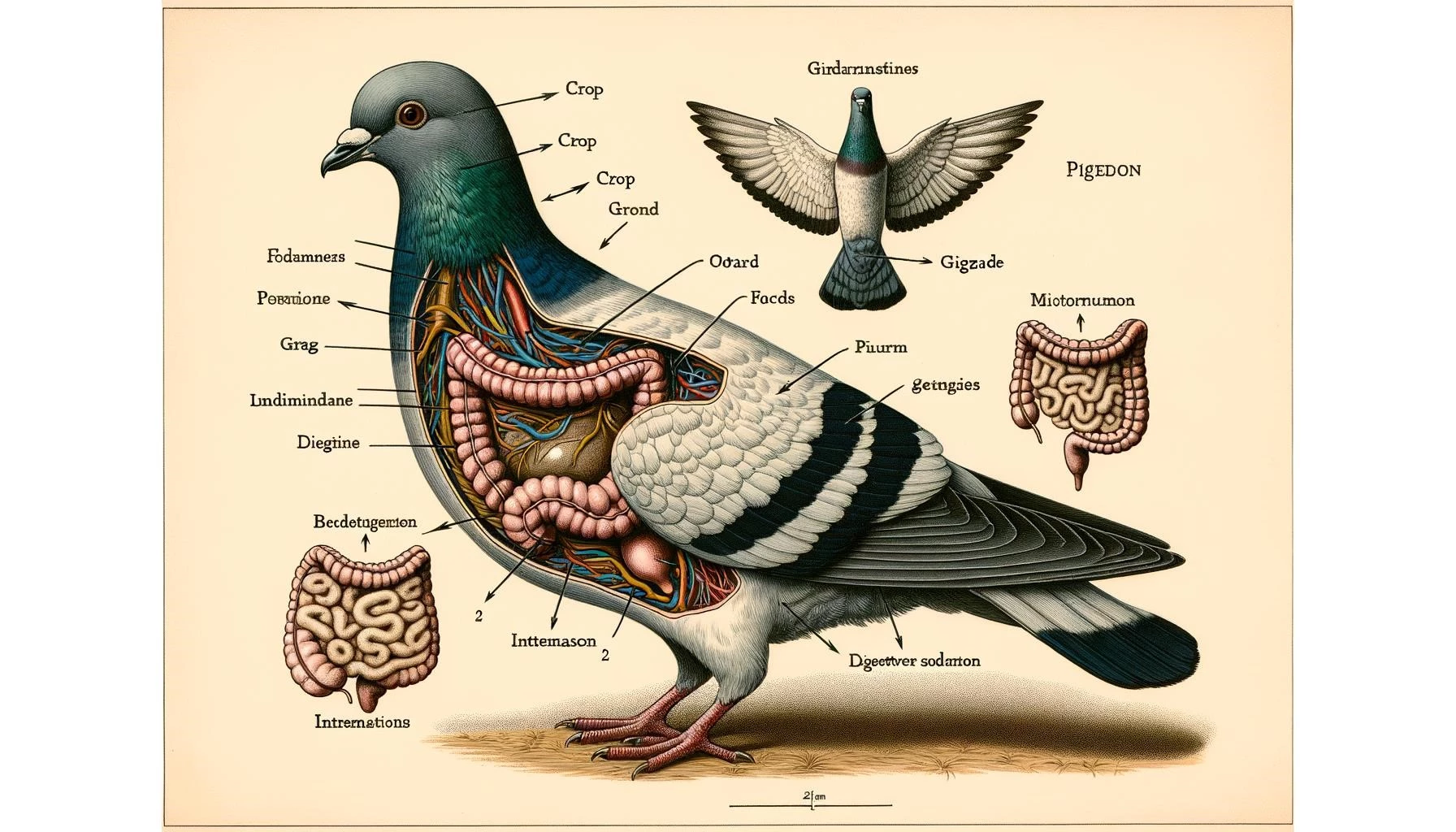Key Takeaways
– The digestive system of pigeons consists of an alimentary canal and digestive glands.
– The alimentary canal includes the mouth, buccal cavity, pharynx, esophagus, stomach, small intestine, large intestine, and cloaca.
– Pigeons have a crop, proventriculus, and gizzard as part of their digestive system.
– The digestive system of pigeons is adapted for the breakdown and assimilation of their ingested food.
Anatomy of the Digestive System
The digestive system of pigeons consists of an alimentary canal and digestive glands. The alimentary canal is a long, tubular, and coiled structure that runs through the pigeon’s body. It includes the mouth, buccal cavity, pharynx, esophagus, stomach, small intestine, large intestine, and cloaca. The different parts of the alimentary canal are adapted for various functions in the digestion and absorption of food.
The mouth of a pigeon is modified into a beak, which lacks teeth. The beak is used for picking up and manipulating food. The food then enters the buccal cavity and is moved to the pharynx for swallowing. From the pharynx, the food passes through the esophagus, which connects the pharynx to the stomach.
The stomach of a pigeon has two parts: the proventriculus (glandular stomach) and the gizzard (muscular stomach). The proventriculus secretes mucus, hydrochloric acid, and pepsinogen, which aids in the breakdown of food. The food then enters the gizzard, where it is mechanically ground and mixed with digestive juices. The gizzard contains small stones that help in the grinding process.
After leaving the gizzard, the partially digested food enters the small intestine. The small intestine is where most of the nutrient absorption takes place. It is divided into three parts: the duodenum, jejunum, and ileum. The lining of the small intestine is covered with villi, finger-like projections that increase the surface area for nutrient absorption.
The large intestine follows the small intestine and is composed of the colon, ceca, rectum, and cloaca. The large intestine is responsible for the absorption of water and electrolytes. It also plays a role in the final stages of digestion and the elimination of waste.
Function of the Digestive System
The digestive system of pigeons is adapted for the breakdown and assimilation of their ingested food. Pigeons are predominantly granivorous, meaning they primarily feed on grains, seeds, and pulses. Their digestive system is designed to process these types of food efficiently.
The beak and tongue of pigeons are well-suited for picking up and manipulating seeds and grains. The lack of teeth is not a hindrance as the gizzard, with its powerful muscular contractions and the presence of stones, grinds the food before it proceeds to the small intestine.
In the proventriculus, digestive juices are secreted to further break down the food through chemical digestion. The gizzard’s mechanical action, combined with the digestive enzymes in the stomach, helps to break down the food into smaller particles for optimal nutrient absorption in the small intestine.
The small intestine is responsible for the absorption of nutrients, including carbohydrates, proteins, and fats. The villi and microvilli lining the small intestine increase the surface area for absorption, ensuring that the pigeon can obtain the necessary nutrients from its food.
The large intestine primarily functions in the absorption of water and electrolytes, helping to maintain proper hydration levels in the bird’s body. It also plays a role in eliminating waste products from the digestive system.
Overall, the digestive system of pigeons is highly efficient in extracting nutrients from their diet of grains and seeds, allowing them to meet their nutritional requirements and maintain good health.
Diet and Digestive System
Understanding the digestive system of pigeons is essential for comprehending their dietary needs, health, and reproduction. Pigeons are primarily granivorous, meaning their diet consists mainly of grains, seeds, and pulses. The structure and function of their digestive system have evolved to accommodate this diet.
The beak of a pigeon is specifically adapted for picking up and manipulating seeds and grains. The tongue assists in this process, helping to position the food for optimal ingestion. Once the food is swallowed, it passes through the esophagus and enters the stomach.
In the stomach, the food is broken down and mixed with digestive juices. The gizzard then grinds the food to a finer consistency, facilitating further digestion. The small intestine is where most of the nutrient absorption occurs, while the large intestine is responsible for water and electrolyte absorption and waste elimination.
Pigeons require a balanced diet that incorporates the necessary nutrients found in grains, seeds, and pulses. A varied diet helps ensure that the pigeon’s digestive system remains healthy and can effectively extract the nutrients it needs. Providing a diet that mimics their natural feeding habits with appropriate commercial pigeon feed, supplemented with fruits and vegetables, will help maintain their overall health.
In conclusion, the digestive system of pigeons is highly specialized for the breakdown, absorption, and assimilation of their diet of grains, seeds, and pulses. Understanding the intricacies of their digestive system is crucial for providing proper nutrition and ensuring the well-being of these avian creatures.









